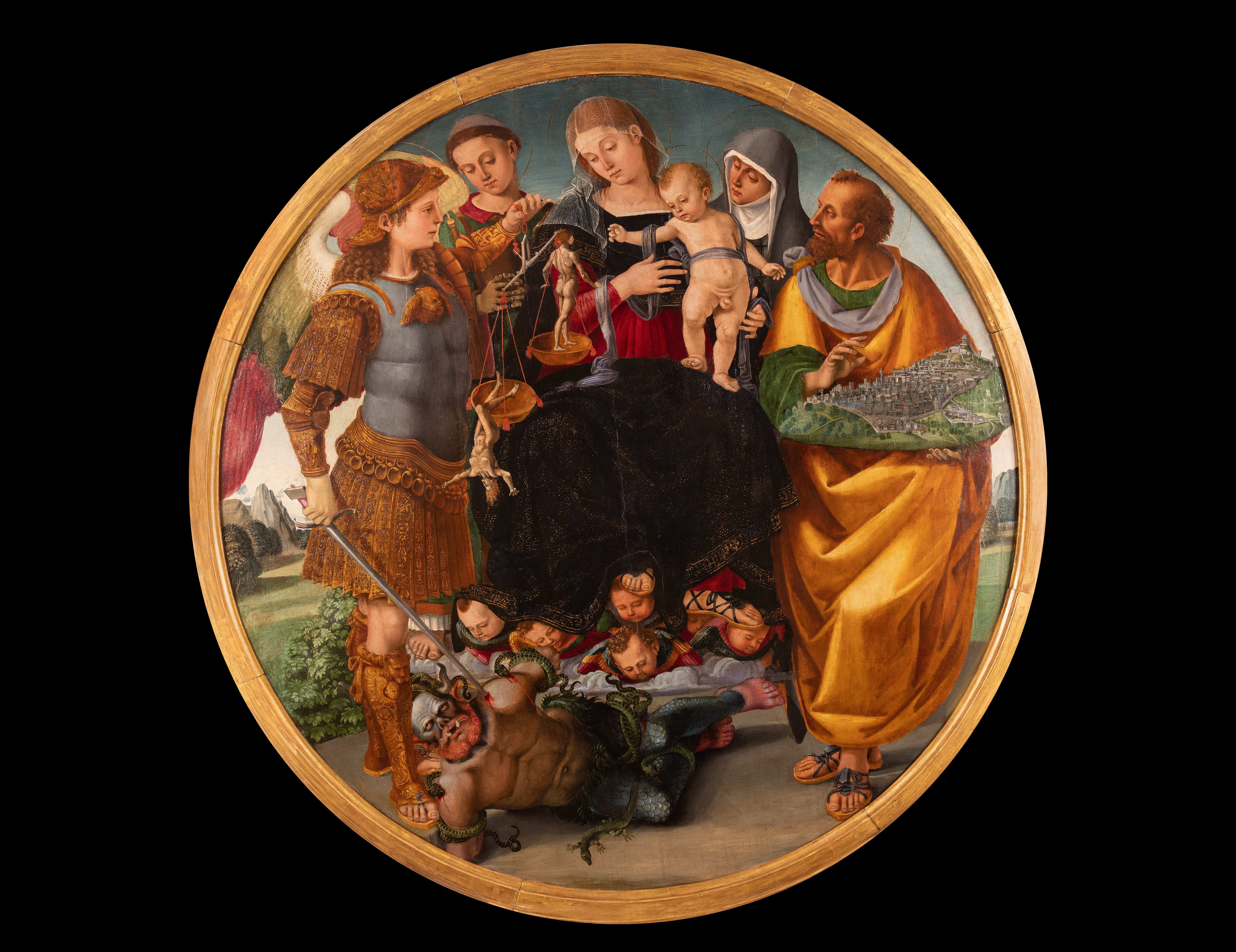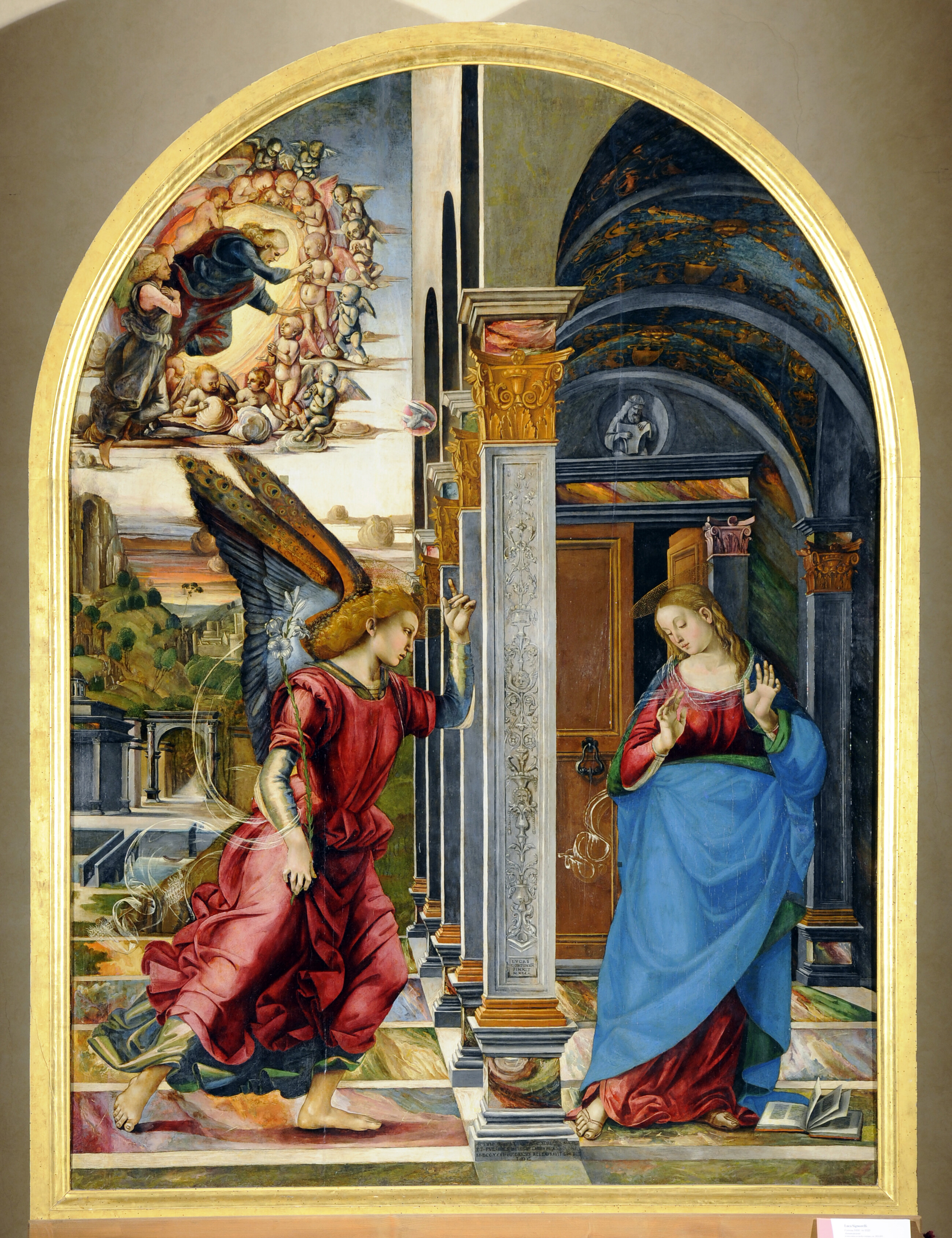Painter of stories
"Twelve some of must for each year at the vendebia." There was also the provision for a supply of wine (twelve some, correspond to about a thousand liters) in the second contract signed by Luca Signorelli—in the Year of Our Lord 1500—with the Opera del Duomo of Orvieto to paint the frescoes in the Chapel of San Brizio, The Last Judgment, which is the Renaissance artist's most famous effort, for its restless, figurative and dramatic images. Like the detail right in the middle of the section on the casting of the damned into Hell, worthy of Dante's scathing tercets in the Divine Comedy: a devil with pointed wings – dark skin and hissing grin – carries on his back, imprisoned in the fate of damnation, a naked, disheveled woman, her face a mask of terror.
Luca Signorelli died in 1523 in his native Cortona, the Etruscan town that was the center from which his art irradiated, spreading throughout central Italy—Tuscany, Marche, Umbria—and as far as Rome, where the commissioning parties were two popes, Sixtus V and Julius II, and where, among other things, he worked on the wall frescoes of the Sistine Chapel, alongside Botticelli, Ghirlandaio, Perugino, and Pinturicchio. All of whom—in terms of visitor attraction—come second to the power of the vault and Last Judgment by Michelangelo.
Cortona, however, shines the light on its most illustrious resident and, for the 500th anniversary of his birth, has devoted an exhibition to him in the medieval Palazzo Casali (through October 8). Thirty works from Italy and abroad—France, England, Ireland, the United States—revive the charisma of Luca, who, born around 1450, trained with Piero della Francesca and in turn inspired Raphael and Michelangelo, who would not have been who they were if it weren’t for Signorelli. This is pointed out by the curator of the exhibition, Tom Henry, professor emeritus of the University of Kent and a great expert on Signorelli; a most enjoyable job, moreover, because it allowed him long sojourns in the Val di Chiana, among vineyards, olive trees, cypresses and sunflower fields.

The beautiful Skira catalog features an essay by Vittorio Sgarbi that traces a precise identikit of the artist. Luca da Cortona inherited the combative, vitalistic side of Piero della Francesca (Perugino, on the other hand, exalted his intimist side) and above all anticipated the dramatic tension of Michelangelo. He was later “rediscovered” by the Pre-Raphaelites, fascinated by his emotionality, and greatly appreciated by Berenson, the supreme art historian. Tom Henry confirms that he was a great colorist, Signorelli. And he was also a painter capable of sculpting figures and inventing stories, his imagination derived from knowledge of texts and the incorporation, in his paintings, of the chronicle of his own life experience.
Thus he brings emotion to the Annunciation, now held in Volterra, in which the Archangel Gabriel almost glides before the Virgin Mary, one foot raised, the other anchored on the marble inlay floor whose alternating colors enhance the perspective, with his ruffled red, iridescent robe contrasting with the full-bodied and immanent blue cloak worn by Mary. In her downward gaze, Mary already accepts the miraculous conception and yet the shaking she feels inside is perfectly conveyed by the book she had been reading that has fallen from her hand, the pages open at her feet.
Thus he brings emotion to the Annunciation, now held in Volterra, in which the Archangel Gabriel almost glides before the Virgin Mary, one foot raised, the other anchored on the marble inlay floor whose alternating colors enhance the perspective, with his ruffled red, iridescent robe contrasting with the full-bodied and immanent blue cloak worn by Mary
The exhibition—entitled ‘Signorelli 500’—is also a restoration opportunity for a number of paintings: such as the Madonna and Child with Saint John the Baptist and a Shepherd loaned from the Musée Jacquemart-André in Paris, a tondo (the sky added at the top turned it into an oval in 1914) in which the position of the Virgin is similar to that of the Annunciation but the cloak is dark blue and, in fact, the restoration revealed on the velvety drapery a punctuation of tiny stars.
Again, resplendent after careful cleaning are the Four Standing Figures on a fragment of the Matelica Altarpiece, thus named because it was commissioned by a wealthy doctor from the Marche who had married a woman from Cortona. It depicts the Lamentation over the Dead Christ (with a glimpse of the Calvary above and the Resurrection below) but was literally cut into pieces in the late eighteenth and early nineteenth centuries, of which six sections are exceptionally brought together in the exhibition. A puzzle pieced together after a series of “finds” the last of which—the head of the fainting Madonna, with the head of her Son resting in her lap—was only identified during an auction in Brussels in 2019. The other parts are precisely the Four Standing Figures, newly restored and in private hands; the aforementioned Calvary, preserved in the National Gallery in Washington; a Man on a Ladder, who took Christ down from the Cross, from the National Gallery in London; a moving Holy Woman Weeping from the Municipal Collections of Bologna; and the Head and Bust of the Dead Christ, also from Bologna, owned by Unicredit.
Still untraceable is the piece on the Resurrection, last certified by two scholars in 1956 in the hands of the art merchant Albrighi before it disappeared. But in the meantime, the fragments give an account of a complex and dramatic work, produced after another Deposition, one of Signorelli's works that remained in Cortona, in the Museo Diocesano, from where it traveled the short distance to the Palazzo Casali exhibition, along with the Communion of the Apostles, admirable especially in the disturbing posture of Judas, already pocketing the money he accepted for the betrayal.

Also restored for the occasion was a large tempera/oil on wood, Madonna and Child with Saints, commissioned from Signorelli by the nuns of a convent in Arezzo. He made it a year before his death, together with his grandson Francis and assistants. “It was carried from Cortona to Arezzo,” writes Vasari, who was nine years old at the time, “and Luca, as old as he was, wanted to come and put it up, and partly to see his friends and relatives again.” It is not part of the exhibition in Cortona (it is almost three and a half meters high and two and a half meters wide) but it remains on view in the National Museum of Medieval and Modern Art in Arezzo and is thus the destination of one of the five routes for discovering Signorelli suggested by the exhibition, within an ideal map of two concentric circles, one within seventy kilometers of Cortona, the other further afield.
After all, the artist was “itinerant,” traveling with his horse from his own town to contract works, which he then created in his workshop, never straying too far away for too long, partly because of the many public offices he held, going so far as to be prior twelve times. “Traveling with Luca Signorelli in his Lands” (www.signorelli500.com) is a guidebook produced for the exhibition.
The first tour is within Cortona itself, with a picturesque stop, among others, at what is known as the Palazzone, which stands outside the city walls and offers sweeping views beyond the meadows and across the battlements, over the plain and as far as Lake Trasimeno. The imposing villa was commissioned by Cardinal Silvio Passerini, and the chapel features a fresco depicting the Baptism of Christ in which, on the left, we can admire the artist’s expertise in human anatomy in the two naked men who have just received the sacrament. The fresco dates back to 1523, and it is said that during the work he fell from the scaffolding and later died as a result of the accident.
The first tour is within Cortona itself, with a picturesque stop, among others, at what is known as the Palazzone, which stands outside the city walls and offers sweeping views beyond the meadows and across the battlements, over the plain and as far as Lake Trasimeno
But here are the other suggested routes: In Valdichiana the stops are in Castiglion Fiorentino (a wonderful Lamentation of Christ can be found in the Collegiate Church of San Giuliano), Foiano dello Chiana, Lucignano and Arezzo. On the Tuscan Via Lauretana you simply must stop in Montepulciano, Pienza (the "ideal city" advocated by Pope Pius II Piccolomini, where the church of San Francesco preserves a Madonna with a refined damask robe, her hands protecting the little praying figures at her feet), Asciano (series of frescoes on the life of St Benedict in the Abbey of Monte Oliveto Maggiore) and Siena. In the Valtiberina, the destinations are Città di Castello (many paintings in the Pinacoteca Comunale), the Oratory of San Crescentino in Morra, Citerna, Umbertide and Sansepolcro, which also offers, a few kilometers away, in Monterchi, the opportunity to admire the enchanting Madonna del Parto by Piero della Francesca.
The Perugia-Orvieto route has two stops: the National Gallery in Umbria and the Chapel of San Brizio. Beyond the seventy-kilometer radius, following in Signorelli's footsteps, the routes span from Florence to Fiesole, from Prato to Volterra. Finally, Marche: a Crucifixion in Urbino, two masterpieces in Arcevia and a series of frescoes in the Holy House of Loreto by a Signorelli still in his twenties.
Vasari recalls the elegance and amiability of Luca, who preferred conversation, reading and banquets. In the lands dotted with vineyards and olive trees, following in his footsteps will lift the souls of us weary pilgrims in 2023.
Read
13 giugno 2024
13 giugno 2024